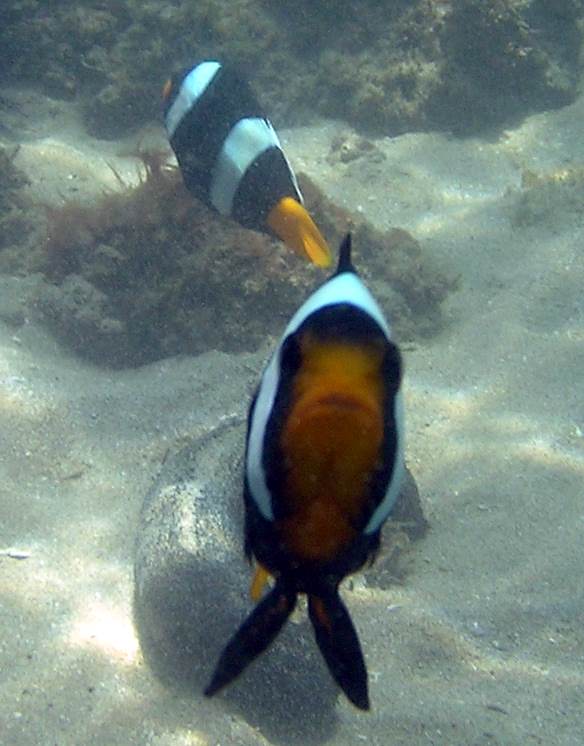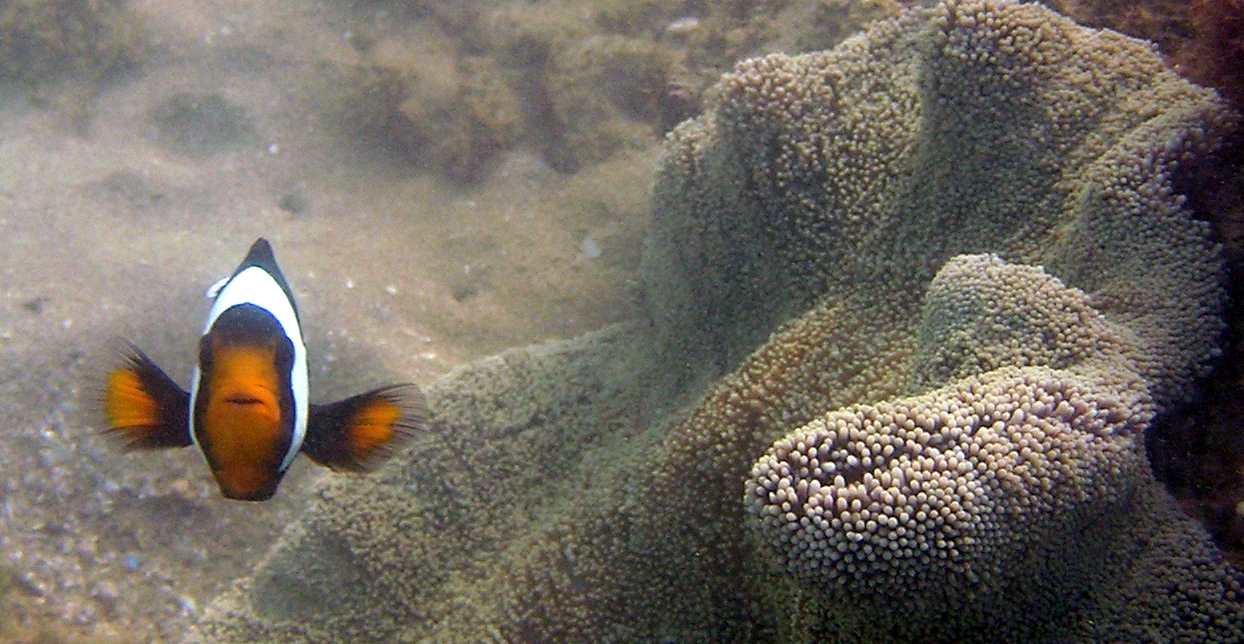zurück Übersicht
Anemonenfisch Cownfisch mit
Koralle Symbiose , einer schützt den anderen
zurück
vor


Ah, it seems like you're referring to
Clownfish! These colorful and
fascinating fish are well-known for their vibrant appearance and their symbiotic
relationship with sea anemones. Here’s an overview of
clownfish:
1.
Appearance
-
Bright Colors: Clownfish are most famous for their striking
orange body with
white bands outlined by
black lines. Some species may have a slight variation in color, such as
yellowish or reddish tones.
-
Size: Clownfish are relatively small, typically growing to around
10 cm (4 inches) in length,
though their size can vary depending on the species.
2.
Habitat
-
Indo-Pacific and Red Sea: Clownfish are typically found in warm
tropical waters of the
Indo-Pacific region and the
Red Sea. They live in
shallow coral reefs, sheltered lagoons, and coastal areas.
-
Sea Anemones: One of the
most interesting aspects of clownfish is their close relationship with
sea anemones. They live
among the stinging tentacles of sea anemones, which provides them with
protection from predators. In return, clownfish help clean the anemones and
may also provide food in the form of small debris.
3.
Symbiotic Relationship with Sea
Anemones
-
Protection: The
stinging tentacles of sea
anemones are dangerous to most fish, but clownfish are
immune to the venom.
Their skin contains a special mucus coating that protects them from the
anemone's sting.
-
Mutual Benefits: This
relationship is mutualistic,
meaning both species benefit:
-
Clownfish: They get
protection from predators such as larger fish and are also provided with
food scraps from the anemones’ meals.
-
Sea Anemones:
Clownfish help keep sea anemones clean by eating small parasites, and
the movement of the clownfish may help circulate water around the
anemones, which can benefit their health.
4.
Diet
-
Omnivores: Clownfish are
omnivores, feeding on a
variety of foods, including algae,
small zooplankton, and tiny invertebrates. They also scavenge food from the
sea anemones they live in.
-
Feeding Behavior: They
can often be seen nibbling on the anemone’s tentacles or hunting for food in
the surrounding area.
5.
Behavior
-
Territorial: Clownfish
are highly territorial, especially around their host sea anemones. They
often defend their territory aggressively from other fish.
-
Social Structure:
Clownfish live in small groups, with a dominant pair consisting of a male
and a female. The female is typically the larger of the two. If the female
dies, the largest male will change sex and become the new female.
6.
Reproduction
-
Spawning: Clownfish lay
their eggs on flat surfaces, typically near their sea anemone home. After
fertilization, the male guards the eggs, fanning them with his fins to keep
them oxygenated.
-
Eggs: The eggs hatch into
larvae, which drift in the open ocean until they settle on a suitable sea
anemone or coral reef.
7.
Popular Species
-
Ocellaris Clownfish (Amphiprion
ocellaris): Often referred to as the "Nemo" fish because of its
fame in the movie Finding Nemo.
It is one of the most common and well-known clownfish species.
-
Percula Clownfish (Amphiprion
percula): A closely related species to the Ocellaris clownfish,
known for its slightly different coloration and more vibrant orange.
-
Clark’s Clownfish (Amphiprion
clarkii): This species is a bit more aggressive and can live with a
wider variety of sea anemones.
8.
Aquarium Trade
-
Popular Aquarium Fish:
Clownfish are very popular in the aquarium trade due to their bright colors
and engaging behavior. They are hardy and easy to care for, making them a
favorite among both beginner and experienced fishkeepers.
-
Captive Breeding: Many
clownfish are now bred in captivity to meet the demand for aquarium fish,
helping protect wild populations.
9.
Cultural Significance
-
"Finding Nemo": Clownfish
gained widespread popularity after the release of the animated film
Finding Nemo (2003). The movie
features a clownfish named Marlin who embarks on a journey to find his son,
Nemo, making clownfish famous worldwide.
-
Symbol of Symbiosis:
Clownfish have become a symbol of mutualistic relationships in nature, often
used in educational contexts to illustrate how different species can benefit
from working together.
Fun Facts:
- Clownfish have
no natural predators when
they are in the protective embrace of their sea anemones, thanks to the
anemone’s venomous tentacles.
- Some clownfish species can change sex
during their lifetime—usually when there is a need to establish a new
dominant breeding pair in the group.
In summary, clownfish are
fascinating, colorful fish with a strong, protect
 26.07.25 Copyright Dirk
Rauschenbach Koelnerstrasse 293 51702 Bergneustadt
Datenschutzerklaerung 02261 9788972 Mail ccooly(
at) web.de
26.07.25 Copyright Dirk
Rauschenbach Koelnerstrasse 293 51702 Bergneustadt
Datenschutzerklaerung 02261 9788972 Mail ccooly(
at) web.de
 Safaris
Bergsteigen
Wandern
Inselwandern Weltweit
Safaris
Bergsteigen
Wandern
Inselwandern Weltweit
 Europa
Inselwandern
Europa
Inselwandern
 Städtewandern
Städtewandern
 Paintings
Paintings Dirk Rauschenbach
Dirk Rauschenbach
 Safaris
Bergsteigen
Wandern
Inselwandern Weltweit
Safaris
Bergsteigen
Wandern
Inselwandern Weltweit
 Europa
Inselwandern
Europa
Inselwandern
 Städtewandern
Städtewandern
 Paintings
Paintings Dirk Rauschenbach
Dirk Rauschenbach
![]() 26.07.25 Copyright Dirk
Rauschenbach Koelnerstrasse 293 51702 Bergneustadt
Datenschutzerklaerung 02261 9788972 Mail ccooly(
at) web.de
26.07.25 Copyright Dirk
Rauschenbach Koelnerstrasse 293 51702 Bergneustadt
Datenschutzerklaerung 02261 9788972 Mail ccooly(
at) web.de